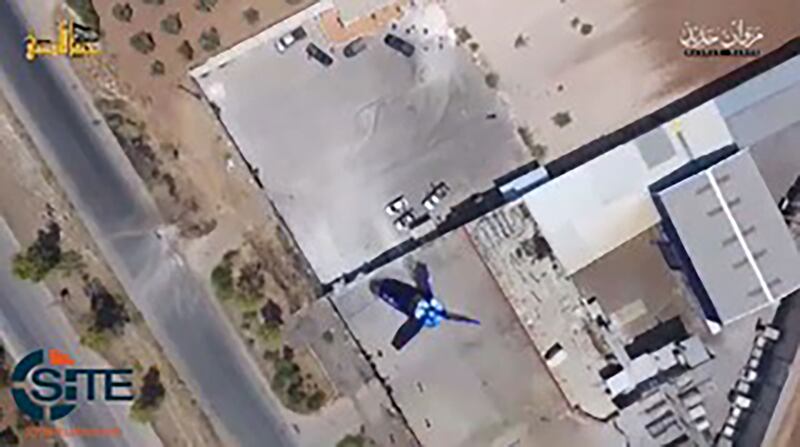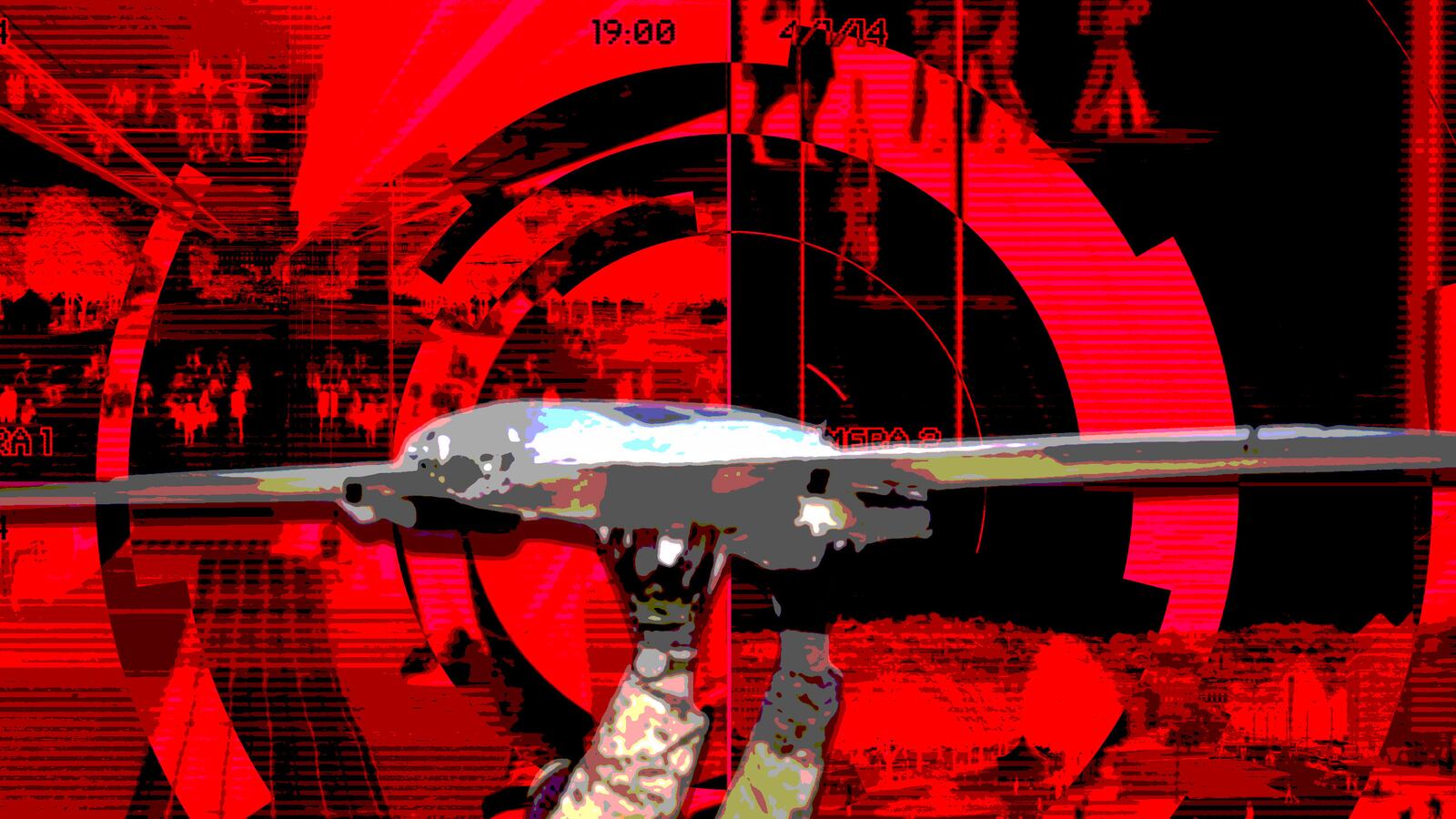On January 23, the Islamic State (IS) released a trailer for an upcoming video from its Ninawa Province, something it only does for major releases, teasing what would become an unfolding media campaign. At the time, Iraqi and allied military forces were three months into their ongoing offensive to take back Mosul, the de facto capital of the so-called Islamic State in Iraq. But apart from its reported military operations, ISIS had yet to make any significant commentary on the largest symbolic and tactical threat it had ever faced—a strange streak of silence from such a media-rich organization.
Footage in the 45-second trailer showed a suicide attacker, his attack, and some urban combat. Pretty much what you’d expect.
But at the end was something else: aerial footage of a mortar dropped from the sky, followed by a shot of an unmanned aerial vehicle, or UAV, from the ground.
ISIS released the full video the next day, calling it “The Knights of the Sectors.” Most of the 38 minute, 33 second video shows extensive footage of combat and car bomb suicide operations against Iraqi and allied forces. The last six minutes, however, shows two fighters launching a drone into sky, followed by aerial footage of attacks. A narrator in the video states of the UAVs:
And Allah’s liberation became clear to His worshippers the mujahideen, where He guided them to the best techniques to destroy the enemies of the faith and the religion. Just as the explosives-laden vehicles had become the worst nightmare of the disbelievers, leaving them sleepless, days and nights, another nightmare came for them from over their heads, to make their lives more restless and miserable.
This advance in drone warfare crossed a battlefield threshold, and opened the door for other terrorist groups do the same. In some ways, you could call it a media stunt. But of course, it’s much more than that. For terrorist groups—especially ISIS—a media stunt is often its most valuable asset.
To the pro-ISIS community, the group’s drone strikes are more than just attacks; they are legitimizing elements to ISIS’ “statehood,” and affirmation of its perceived formidability against the world’s military powers—not to mention a morale boost as the group loses territory in Iraq and Syria.
An Emboldened Community
Already promoting and praising the trailer, ISIS’ supporters went into full celebratory campaign-mode after the release of “The Knights of the Sectors.” The internet-party included artwork and infographics for the UAV attacks, as well as threats. Among them were images depicting the fighters from the “Knights of the Sectors” video launching the UAVs toward the U.S. Capitol Building and the Statue of Liberty.

Supporters even spit-balled ideas for how to improve the weaponized UAVs and reap maximum damage. One pro-ISIS military analyst posted his take on his Telegram channel on February 5, detailing which locations would serve as the “easiest targets,” and how ISIS could seize any anti-aircraft weaponry potentially supplied to Iraqi and allied forces “as spoils.” He exclaimed:
After the planes, there are still a lot more surprises. If it were not for this comprehensive war upon my State, we would have not witnessed this development and we would have procrastinated and became inefficient. It is the will of the Lord of the Worlds that we give all that we have to deserve victory form Allah.

Another supporter on the pro-ISIS forum al-Minbar stated:
The use of the bombing drones is a joy for every supporter, but we are hoping from our manufacturing specialists of the State to increase the explosive capacity for each and every rocket that is launched from those planes, which will have a huge role in reversing the outcome of the battle. I ask Allah to facilitate that within the coming days…
The discussions have looked like brainstorming sessions for a twisted engineering project, with detailed suggestions ranging from dropping “nails or shrapnel” from the UAVs, to arming them with poisons and incendiary materials. One supporter even suggested using uranium:
The only effective way is to increase the explosive power by using uranium or the explosive HMX or something similar to it, or increasing the size of the drone to withstand carrying a heavier load of explosives, or, as a few of our brothers had suggested, using balloons to carry and drop the explosives.
ISIS probably won’t be using uranium any time soon. But ISIS has proven itself as a tech-savvy organization, and the success the group has had thus far will very likely make further development efforts a top priority within its organization. And when they do make advances, ISIS will make sure the world knows about them.
ISIS’ Military-Media Link
No group has ever extracted as much propagandic value out of its activity than ISIS. Al Qaeda in Iraq, IS’ predecessor led by Abu Musab al-Zarqawi, explained the significance of media—especially videos—in an article in the July 2005 issue of its magazine, “Thurwat al-Sanam” (meaning, “Top of the Camel’s Hump”). He stressed not to let any military operation be followed by “complete silence,” but to instead “publicize it.” The article also stated:
How many battles has this nation lost because the lack of media/information? This is because of neglecting this aspect [of jihadi media]. Some look at the military fight as the most important thing, and others are not important. This is a shortsighted [view].

Over a decade later, the world has seen this philosophy manifest into a colossal propaganda machine. No act—from the beheading of spies, to the packaging of water bottles—is left untapped by ISIS’ media teams. It is through this world of media that the group projects its Caliphate to supporters in the West and around the world, whether they be media workers or lone wolf attackers.
ISIS’ drone attacks, to that point, have become a special media priority for the group. Consider the calculated way in which ISIS introduced its UAVs to the world.
Reports of ISIS using weaponized UAVs in northern Iraq had existed long prior to its release of “The Knights of the Sectors,” and recovered documents show that the group’s “Department of Aviation” has been at work on them since at least as early as 2015. Still, the world’s understanding of these UAVs prior to ISIS’ introduction was limited to scant photo work of destroyed machinery and statements by military officials. Its supporters and the rest of the world had yet to see them.
Knowing this, ISIS’ media and military wings, in their standard collaborative fashion, waited until this past January to show the UAVs, despite having already used them. The group did so in a slow drip—first with the trailer with the brief aerial footage, then the high-quality “Knights of the Sectors” video release—and has since pushed out an ongoing flow of photo reports statements of further drone strikes.
The results: countless media articles and TV spots on the UAV attacks.
Now, compare this hype to that received by Jund al-Aqsa, a now-disbanded pro-al Qaeda Syrian jihadist group, which released its own video of a weaponized UAV attack in September of 2016 (months before ISIS’ “The Knights of the Sectors” video). A screenshot from the video, looking remarkably similar to ISIS’ UAV attack photo reports, follows:

Despite the similarities, you probably didn’t hear about Jund al-Aqsa’s UAV attack, while three months later, you couldn’t open up a news blog without seeing stories of ISIS’.
ISIS’ military activity is inseparable from its media; an ISIS attack and a media release are of the same process. This is what has made the group such a uniquely global phenomenon, far surpassing any such efforts of al-Qaeda and other rival jihadi groups. It is why ISIS-inspired attacks in Nice, Berlin, and elsewhere mirror directions offered by ISIS leadership speeches and guides in its magazines. These attackers are not trained operatives; they are supporters who only needed a smart phone and social media profiles.
So when we talk about the battlefield implications of these weaponized UAVs, we shouldn’t ask if a given development is merely propaganda, because that propaganda is just as much a weapon as the rigged UAV dropping explosives onto the ground.





